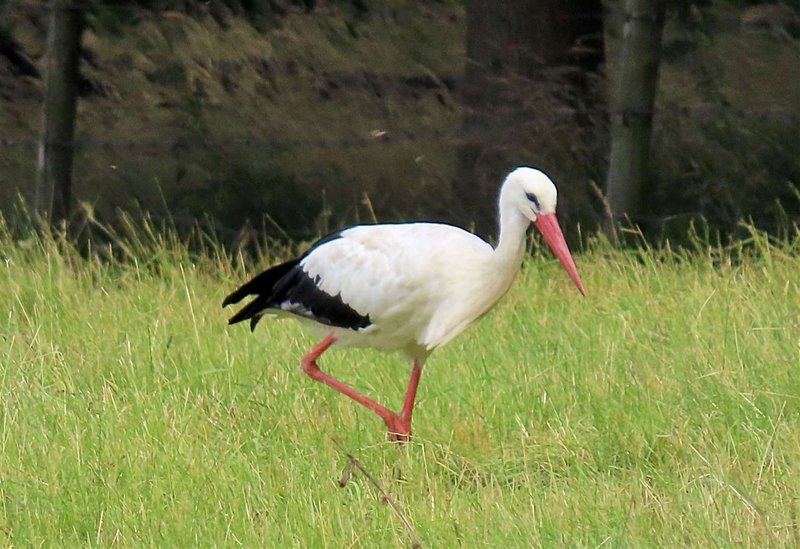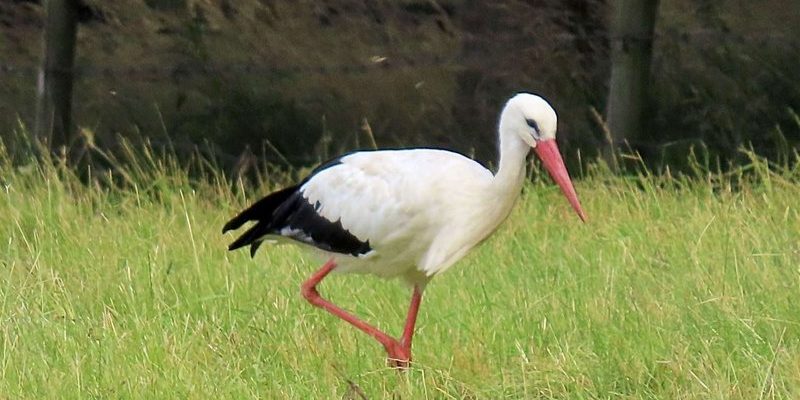
Have you ever spotted a bird so strikingly beautiful that it took your breath away? Enter the Black Stork—a bird that seems too elegant to exist in the ordinary world. With its glossy black feathers and graceful silhouette, this stork is a true marvel of nature. Unlike its more commonly seen relative, the white stork, the Black Stork keeps a low profile, often living in remote wetlands and forests. Its elusive nature only adds to the intrigue of this fascinating species.
You might find yourself wondering about the life of the Black Stork. Where does it live? What does it eat? And how does it manage to be both a skilled hunter and a symbol of mystery? In this article, we’ll delve deep into the life of the Black Stork, exploring its habitat, behavior, diet, and much more.
Physical Characteristics
The Black Stork truly stands out among its feathered peers. The most obvious feature is its black plumage, which appears almost iridescent in the sunlight, shifting shades of green and blue. The contrasting white belly and red legs add a striking touch to its overall appearance. This bird is a bit more petite than the white stork, with adults reaching about 66 to 75 cm in length, and a wingspan of approximately 1.3 to 1.4 meters.
One of the most charming aspects of the Black Stork is its long, slender neck and pointed bill, perfect for spearing fish and other prey. When you see one in flight, its wings are broad and long, allowing for graceful soaring. The Black Stork also possesses striking red eyes, which give it a captivating gaze, making it hard to look away when you spot one in the wild.
Another interesting fact is the somewhat different coloration of juvenile storks. Young Black Storks are covered in mottled brown and gray feathers, which offer them better camouflage in their early life stages. As they age, their feathers darken and become more vibrant, marking their transition into adulthood.
Habitat and Range
So where does the Black Stork like to hang out? This species prefers freshwater habitats with plenty of nearby trees for nesting. You’ll often find them in marshes, rivers, and lakes, preferably in undisturbed areas. They thrive in habitats that provide both water and vegetation, so they can hunt while also staying hidden from predators.
Geographically, the Black Stork has a wide range. They can be found in places from Europe to parts of Asia and northern Africa. Some populations migrate seasonally, traveling thousands of miles to escape the cold winters. During migration, you can often see them soaring high in the sky, using thermal currents to conserve energy.
This bird’s choice of habitat plays a significant role in its survival. Wetlands serve as a source of food, while trees provide safe nesting sites away from ground predators. Unfortunately, habitat loss due to human activities has put pressure on Black Stork populations, making the preservation of these habitats more critical than ever.
Diet and Feeding Habits
The Black Stork is a skilled hunter, often employing a stealthy approach when foraging. Their diet primarily consists of fish, but they aren’t picky eaters. You might catch them snatching up frogs, insects, and even small mammals when the opportunity arises. Their long, pointed bills are perfectly designed for probing into shallow waters, where they can detect movement and pounce on their prey.
Feeding usually occurs during the early morning or late evening, when the sun is lower in the sky and the water is cooler. This time of day is often the best for spotting them at work, as they wade through the shallows, carefully scanning for any sign of movement. Once they spot a meal, they can strike with incredible speed. It’s almost like watching a magician pull a rabbit out of a hat, but instead, it’s a fish!
Interestingly, Black Storks are also known to hunt in pairs or small groups. Working together allows them to cover more ground and increases their chances of a successful catch. You may see them engaging in a delicate dance, moving in sync as they search for food—yet another reminder of their remarkable adaptability in the wild.
Behavior and Social Structure
When it comes to behavior, the Black Stork is primarily solitary, preferring to keep to itself or only with a mate. However, they can be seen congregating at feeding sites during migration, where they may form temporary flocks. Their quieter nature sets them apart from the more boisterous white stork, making them a joy to observe for birdwatchers seeking peace and tranquility in nature.
During the breeding season, these storks display fascinating courtship behavior. Males perform elaborate aerial displays to attract females, showcasing their agility and fitness. Once paired, they work together to build a sturdy nest, often in the treetops, which can be quite a feat considering their long legs and large size.
After laying their eggs, both parents take turns incubating them. This shared responsibility is a beautiful aspect of their social structure, as it strengthens the bond between mates and ensures the survival of their young. The chicks are cared for until they can fend for themselves, and even after fledging, they may stay close to their parents for some time, learning the ropes of survival in the wild.
Conservation Status
The Black Stork is currently classified as a Near Threatened species, primarily due to habitat loss and human activities. Wetlands are being drained and converted for agriculture, which impacts the availability of suitable breeding and feeding grounds. As a result, conservation efforts are vital to ensure this breathtaking bird continues to thrive.
In recent years, various organizations have been working hard to protect their habitats and raise awareness about the importance of wetlands. Establishing protected areas and promoting sustainable land-use practices are crucial steps in this fight.
Every sighting counts. If you’re lucky enough to see a Black Stork, consider yourself fortunate! You’re witnessing a beautiful piece of biodiversity that plays an essential role in its ecosystem. Supporting conservation efforts, whether through advocacy or simply by enjoying and respecting nature, can help ensure these magnificent birds have a future.
Interesting Facts
Here are some facts that might surprise you about the Black Stork:
- They have been known to fly at altitudes of up to 5000 meters during migration.
- Black Storks communicate using a range of clacking and croaking sounds.
- They can live up to 20 years in the wild.
- This species is often a symbol of good fortune in various cultures.
In summary, the Black Stork is more than just a beautiful bird; it’s an integral part of our ecosystem. With its graceful form and fascinating behaviors, it captivates anyone lucky enough to encounter it. By understanding and appreciating these storks, we can play a role in ensuring their survival for future generations. Whether you’re an avid birdwatcher or simply a nature enthusiast, taking the time to learn about the Black Stork enriches your experience in the wild.
FAQ
What is the primary diet of the Black Stork?
The Black Stork primarily feeds on fish, frogs, insects, and small mammals. They are skilled hunters, using their pointed bills to probe into shallow waters to snatch up their prey. Their diet may vary depending on the location and availability of food sources, but they are generally opportunistic feeders.
Where can I find Black Storks?
You can find Black Storks in freshwater habitats, including marshes, rivers, and lakes. They prefer remote areas with abundant vegetation and plenty of trees for nesting. Their range includes parts of Europe, Asia, and northern Africa, with some populations migrating seasonally for warmer climates.
How do Black Storks build their nests?
Black Storks build their nests using twigs and branches, typically high up in trees to protect them from ground predators. They often return to the same nesting sites year after year, adding to their nests over time to create a sturdy structure for raising their young.
Do Black Storks migrate?
Yes, many populations of Black Storks migrate. In search of warmer climates during winter, they travel thousands of miles. Their migration usually takes place in the fall and spring, and you can often spot them soaring high in the sky during these times.
How long do Black Storks live?
In the wild, Black Storks can live up to 20 years, although many do not reach this age due to natural challenges or habitat loss. Their longevity is associated with their ability to find suitable feeding and nesting sites, which can help them thrive.
What are some threats to Black Stork populations?
The primary threats to Black Stork populations include habitat loss due to agricultural expansion, draining of wetlands, and pollution. Climate change also poses a significant risk by altering the ecosystems these birds depend on. Conservation efforts are essential to mitigate these threats and protect their habitats.
Can Black Storks adapt to urban environments?
While Black Storks are predominantly found in natural habitats, some may adapt to nearby urban areas if suitable nesting and feeding sites are available. However, their preference is usually for unspoiled environments where they can hunt and breed with minimal disturbance.
How do Black Storks communicate?
Black Storks communicate using a variety of vocalizations, including clacking and croaking sounds. These calls are often used during courtship or to maintain contact with their mates and young. Their communication is an essential part of their social behavior, especially during breeding season.
Are Black Storks social birds?
Black Storks are generally solitary or found in small family groups. Although they may congregate at feeding sites during migration, they tend to avoid large flocks. Their solitary nature sets them apart from more social species like the white stork.
What can I do to help Black Stork conservation?
You can support Black Stork conservation by advocating for wetland preservation, promoting sustainable land use, and participating in local conservation efforts. Additionally, simply enjoying and respecting their natural habitats can raise awareness about their needs, contributing to their survival.

